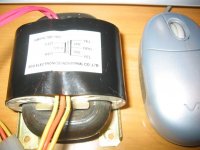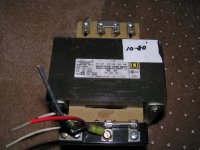Hi,
I´ll find this transfo for a cheap but don´t know if will work for a gainclone, it is a 18-0-18 so that´s ok, but is only 45-60va
(that´s what I found on internet http://www.ecu.com.cn/pro_display.asp?prono=20 (model r35)
, It´s called R type and it´s made especially for audio
any thoughts?, is there a simpler alternative than toroids? (here in chile they are dificult to find)
thank´s

I´ll find this transfo for a cheap but don´t know if will work for a gainclone, it is a 18-0-18 so that´s ok, but is only 45-60va
(that´s what I found on internet http://www.ecu.com.cn/pro_display.asp?prono=20 (model r35)
, It´s called R type and it´s made especially for audio
any thoughts?, is there a simpler alternative than toroids? (here in chile they are dificult to find)
thank´s

Attachments
You can should be able to get at least one channel out of it. To be on the safe side, use a couple of them and make two monoblocks. 😀 As a comparison, I have a 48VCT 80VA torroid I use for monoblocks and they don't seem to be having any trouble at all. With the lower voltage, I am guessing you should be fine. Granted, I am not really driving mine that hard, so YMMV, but my guess is that you should be fine.
Thank´s for your reply, but that was the only one they have, I can still return it or save it for another proyect,
So my question now is, there´s an easy alternative other than toroids?
So my question now is, there´s an easy alternative other than toroids?
fcj said:Thank´s for your reply, but that was the only one they have, I can still return it or save it for another proyect,
So my question now is, there´s an easy alternative other than toroids?
Standard "E" transformers should work okay, as far as I can tell.
R-core transformers were not developed speciffically for audio, although of course they do work very well in that kind of an application 🙂
R-core is a predecessor of the toroid transformer. With the toriod transformer, before an effective winding technique was discovered, winding was tedious and very costly, usually by hand - because the core cannot be dissasembled.
The R-core is made in a similar way like a true toroidal core, a single strip of lamination is profiled for width so that when wound on an oval shape, ends up having a circular cross-section.
The circular cross-section is important because the bobbins are actually wound on teh core itself. The bobbins are made out of 4 parts, actually a tube-like part and a bobbin part, both are made out of two halves. They are assembled on the core itself, forming a round bobbin that can be turned around the tube-like part, through which the core goes. The bobin has an edge made out like a gear, that slots into the winding machine, and turns the bobin on the core, winding the wire onto it.
WIth the advent of cheap toroidal core winders, R-core has become much less popular (it was invented in 1979). Apart from the slightly lower size efficiency and higher stray field (because the windings do not completely cover the core), they are actually very similar to toroids.
R-core is a predecessor of the toroid transformer. With the toriod transformer, before an effective winding technique was discovered, winding was tedious and very costly, usually by hand - because the core cannot be dissasembled.
The R-core is made in a similar way like a true toroidal core, a single strip of lamination is profiled for width so that when wound on an oval shape, ends up having a circular cross-section.
The circular cross-section is important because the bobbins are actually wound on teh core itself. The bobbins are made out of 4 parts, actually a tube-like part and a bobbin part, both are made out of two halves. They are assembled on the core itself, forming a round bobbin that can be turned around the tube-like part, through which the core goes. The bobin has an edge made out like a gear, that slots into the winding machine, and turns the bobin on the core, winding the wire onto it.
WIth the advent of cheap toroidal core winders, R-core has become much less popular (it was invented in 1979). Apart from the slightly lower size efficiency and higher stray field (because the windings do not completely cover the core), they are actually very similar to toroids.
ok, so what´s an standard "E" transformer? What do they look like?
sorry for the soo newbie questions!😕
sorry for the soo newbie questions!😕
R-Cores see use alot where separate bobins for primary and secondary are mandated.
An EI core is the traditional transformer type. The core is composed of alternating E and I laminations, the windings go on the slot formed around the center E leg. Heres a picture of one. The E is pointing downward alternating upward here.
An EI core is the traditional transformer type. The core is composed of alternating E and I laminations, the windings go on the slot formed around the center E leg. Heres a picture of one. The E is pointing downward alternating upward here.
Attachments
Hi fcj: 🙂 🙂 🙂
It's nice to see a fellow countryman here at the forums.
As my limited knowledge allow me to answer:
It refers to "EI" transformers. They are the "common type" square laminated ones. They are called as such because the lamination form an "E" and an "I" wich are joined to form the nucleus. They are less efficient than toroid (size to size)but due to less extended bandwidth they are supposed to catch less noise form the mains.
R-core are also bandlimited due to separated windings and that kind of isolation from mains is supposed to be GOOD FOR AUDIO, the same as "EI" Tx.
You can source bigger R-core TX ( 200VA, 400VA) from diyclub:
http://eshop.diyclub.biz/index.php?cPath=152_74
But shipment from Asia takes about 6 weeks by surface 🙁
I'm still waiting mine
Try RS-components or RS-online and then click "RS worldwide" -->Chile--> electronic-->transformers->toroidal.
They are not so cheap but price includes shiping and taxes/customs. Toroidals are more efficient but have wider bandwidth, so if your mains are dirthy, as everywhere, you could have HF noise problems (as I do).
Well, I hope that helps.
Feel free to mail me if you want ( I feel so alone here )
)
I'll do my best to help you.
Mauricio
It's nice to see a fellow countryman here at the forums.
As my limited knowledge allow me to answer:
ok, so what´s an standard "E" transformer? What do they look like?
It refers to "EI" transformers. They are the "common type" square laminated ones. They are called as such because the lamination form an "E" and an "I" wich are joined to form the nucleus. They are less efficient than toroid (size to size)but due to less extended bandwidth they are supposed to catch less noise form the mains.
R-core are also bandlimited due to separated windings and that kind of isolation from mains is supposed to be GOOD FOR AUDIO, the same as "EI" Tx.
You can source bigger R-core TX ( 200VA, 400VA) from diyclub:
http://eshop.diyclub.biz/index.php?cPath=152_74
But shipment from Asia takes about 6 weeks by surface 🙁
I'm still waiting mine

In general I preferr not to save $ on transformers with amps. I'm sure there are some members better qualified to advice you but I would recommend a bigger one, like 225VA: better regulation and hopefully better bass response.18-0-18 so that´s ok, but is only 45-60va
here in chile they are dificult to find
Try RS-components or RS-online and then click "RS worldwide" -->Chile--> electronic-->transformers->toroidal.
They are not so cheap but price includes shiping and taxes/customs. Toroidals are more efficient but have wider bandwidth, so if your mains are dirthy, as everywhere, you could have HF noise problems (as I do).
Well, I hope that helps.
Feel free to mail me if you want ( I feel so alone here
 )
)I'll do my best to help you.
Mauricio
Hi Mauricio, thank´s for your reply, glad to hear another chilean here!
I´ll send you soon a mail soon😉
I think I will order an toroid from http://www.rschile.cl
I´ll send you soon a mail soon😉
I think I will order an toroid from http://www.rschile.cl
OK, compadre, but first try RS-online because on RS-chile the catalog is often reduced. When you find your desired item just copy its RS code and paste it on the RS-chile "search" tool.
Good luck.
Mauricio
Good luck.
Mauricio
- Status
- Not open for further replies.
- Home
- Amplifiers
- Chip Amps
- Type R transformer for gainclone

